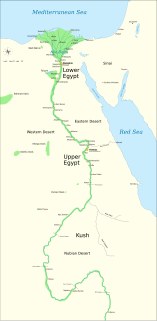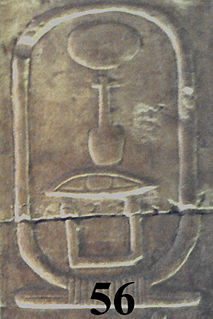Related Research Articles

The First Intermediate Period, described as a 'dark period' in ancient Egyptian history, spanned approximately 125 years, c. 2181–2055 BC, after the end of the Old Kingdom. It comprises the Seventh, Eighth, Ninth, Tenth, and part of the Eleventh Dynasties. The concept of a "First Intermediate Period" was coined in 1926 by Egyptologists Georg Steindorff and Henri Frankfort.

Sehertawy Intef I was a local nomarch at Thebes during the early First Intermediate Period and the first member of the 11th Dynasty to lay claim to a Horus name. Intef reigned from 4 to 16 years c. 2120 BC or c. 2070 BC during which time he probably waged war with his northern neighbor, the Coptite nomarch Tjauti. Intef was buried in a saff tomb at El-Tarif, known today as Saff el-Dawaba.
Intef III was the third pharaoh of the Eleventh Dynasty of Egypt during the late First Intermediate Period in the 21st century BC, at a time when Egypt was divided in two kingdoms. The son of his predecessor Intef II and father of his successor Mentuhotep II, Intef III reigned for 8 years over Upper Egypt and extended his domain North against the 10th Dynasty state, perhaps as far north as the 17th nome. He undertook some building activity on Elephantine. Intef III is buried in a large saff tomb at El-Tarif known as Saff el-Barqa.

The necropolis of Draʻ Abu el-Naga' is located on the West Bank of the Nile at Thebes, Egypt, just by the entrance of the dry bay that leads up to Deir el-Bahari and north of the necropolis of el-Assasif. The necropolis is located near the Valley of the Kings.

El-Tarif is a necropolis on the West Bank of the Nile, at the site of ancient Thebes (Luxor), Egypt. It is located in the northwestern outskirts of Luxor and southeast of the Valley of the Kings, opposite Karnak, just to the southwest of the modern village of At-Tarif. It is the oldest of West Thebes' necropolises. It is a small mortuary temple, and the farthest north of the Tombs of the Nobles, and contains tombs of the late First Intermediate Period, Second Intermediate Period and early Middle Kingdom. Old Kingdom mastabas are possibly attributed to local rulers of the Fourth or Fifth Dynasty. Eleventh Dynasty tombs of local rulers have also been noted in the form of a series of rock-cut tombs dated to 2061-2010 B.C.E, the largest of which are Intef I to Intef III, who were kings of this dynasty.

Nubkheperre Intef was an Egyptian king of the Seventeenth Dynasty of Egypt at Thebes during the Second Intermediate Period, when Egypt was divided by rival dynasties including the Hyksos in Lower Egypt.

Sekhemre Wadjkhaw Sobekemsaf I was a pharaoh of Egypt during the 17th Dynasty. He is attested by a series of inscriptions mentioning a mining expedition to the rock quarries at Wadi Hammamat in the Eastern Desert during his reign. One of the inscriptions is explicitly dated to his Year 7. He also extensively restored and decorated the Temple of Monthu at Medamud where a fine relief of this king making an offering before the gods has survived.

Sekhemre-Wepmaat Intef-Aa was an Ancient Egyptian pharaoh of the 17th Dynasty of Egypt, who lived late during the Second Intermediate Period, when Egypt was divided into two by Hyksos controlled Lower Egypt and Theban ruled Upper Egypt.

Neferkauhor Khuwihapi was an ancient Egyptian pharaoh of the Eighth Dynasty during the early First Intermediate Period, at a time when Egypt was possibly divided between several polities. Neferkauhor was the sixteenth and penultimate king of the Eighth Dynasty and as such would have ruled over the Memphite region. Neferkauhor reigned for little over 2 years and is one of the best attested kings of this period with eight of his decrees surviving in fragmentary condition to this day.

Neferirkare was an ancient Egyptian pharaoh of the Eighth Dynasty during the early First Intermediate Period. According to the egyptologists Kim Ryholt, Jürgen von Beckerath and Darrell Baker he was the 17th and final king of the Eighth Dynasty. Many scholars consider Neferirkare to have been the last pharaoh of the Old Kingdom, which came to an end with the 8th Dynasty.

The stone quarries of ancient Egypt once produced quality stone for the construction of decorative monuments such as sculptures and obelisks. These quarries are now recognised archaeological sites. Eighty percent of the ancient quarry sites are in the Nile valley; some of them have disappeared under the waters of Lake Nasser and some others were lost due to modern mining activity.

The ancient Egyptian noble Intefiqer(ỉnỉ-ỉt.f ỉqr) was overseer of the city and Vizier under Amenemhet I and Senusret I during the early 12th Dynasty. He is known from several rock inscriptions in Lower Nubia, showing that he was part of a military mission into this region. He appears in an inscription found at the Red Sea coast and in the so-called Reisner Papyrus. Two rock inscriptions in Lower Nubia mention him. They seem to indicate that he was involved in a military campaign into this region. The inscriptions are not dated, but other inscriptions in the region seem to indicate a military campaign in year 29 of Amenemhet I, which corresponds to the 9th year of Senusret I. Intefiqer is also known from a stela found at Wadi el-Hudi, dated to year 20. It reports the bringing of Amethyst.

Wadi Hammamat is a dry river bed in Egypt's Eastern Desert, about halfway between Al-Qusayr and Qena. It was a major mining region and trade route east from the Nile Valley in ancient times, and three thousand years of rock carvings and graffiti make it a major scientific and tourist site today.
This page list topics related to ancient Egypt.

Shemay was an ancient Egyptian official and later vizier toward the end of the 8th Dynasty during the First Intermediate Period, mainly known for being the beneficiary of most of the Coptos Decrees. His career has been interpreted as a glaring sign of the extreme weakness of the central power, forced to bestow great privileges to maintain the loyalty of powerful local governors. Shemay is buried in a mudbrick mastaba just south of Coptos.
Iushenshen was an ancient Egyptian town in the Coptic nome in Upper Egypt. It is a few times mentioned in Ancient Egyptian sources. According to the Ramesside Onomastica the place was located south of Coptos. 25 km (16 mi) south of Coptos there is the modern town called Khozam where ancient monuments have been found, and it seems possible that Khozam was ancient Iushenshen. Near Khozam were excavated several cemeteries with some of them dating back to the Badarian Period. Near Khozam the false door of the local governor User and the false door of the overseer of Upper Egypt Tjauti were also found, they date to the very end of the Old Kingdom. These high officials were evidently buried here and it seems that the capital of the Coptite nome moved at the end of the Old Kingdom to this place. Iushenshen was destroyed in the First Intermediate Period. A stela of a certain Khenmes reports that he was sent to the town and rebuilt it.

Idy was an important Ancient Egyptian official in the Eighth Dynasty known from several sources. He lived at the beginning of the First Intermediate Period and was the son of Shemay, who is also known from several monuments and decrees from Koptos. His mother was the king's daughter Nebet. Idy appears on many royal decrees found at Koptos. There he bears the important title of a vizier, but was also overseer of Upper Egypt and overseer of priest and count. The decrees are dated under king Neferkauhor and Neferirkare. One decree is addressed to Shemay and dates under Neferkauhor. It reports the appointment of Idy to the overseer of Upper Egypt. A second one mentions affairs in the temple of Min at Koptos. In a third decree Idy bears the titles of a vizier. In the decree, the king protects the statues and the funerary cult of Idy. The decree is dated under king Neferirkare, who was the successor of Neferkauhor. It seems that Idy took over many positions that his father hold before.
User was an ancient Egyptian nomarch (governor) of the Eight Dynasty. User is mainly known from a false door found at Khozam in 1884. The monument is about one meter high and is made of graywacke. It is today in the Egyptian Museum in Cairo. Here User bears a long string of important titles, such as Father of the god, beloved of the god, Overseer of Upper Egypt, overseer of the desert lands and overlord of the Coptite nome. The latter title is the main title for nomarchs in the late Old Kingdom and First Intermediate Period. Furthermore he was overseer of priests and overseer of the Eastern and Western Deserts. The most unusual title for a nomarch is king's eldest son of his body.
Gebel Tjauti is a rock formation in Egypt. The rock is named after Tjauti, an ancient Egyptian official who lived at the end of the Eighth Dynasty, around 2150 BC.
References
- ↑ Maha Farid Mostafa: The Mastaba of SmAj at Naga' Kom el-Koffar, Qift. Vol. I: Autobiographies and related scenes and texts. Ministry of Antiquities and Heritage, Cairo 2014, ISBN 978-977642004-5, p. 201, pl. XXXII
- ↑ Maha Farid Mostafa: The Mastaba of SmAj at Naga' Kom el-Koffar, Qift. Band I: Autobiographies and related scenes and texts. Ministry of Antiquities and Heritage, Cairo 2014, ISBN 978-977642004-5, 200-201
- ↑ John C. Darnell: Theban Desert Road Survey in the Egyptian Western Desert, Vol. 1, Gebel Tjauti Rock Inscriptions 1-45 and Wadi el-Hol Rock Inscriptions 1-45, Chicago 2002, ISBN 1-885923-17-1, p. 30-46